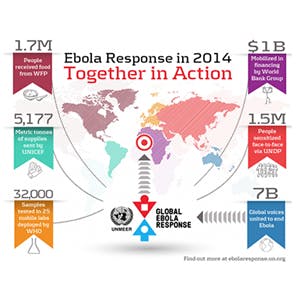“When our children are sick, when are children are dying, we can’t hold them at a time when we want to be closest to them. When our relatives die, we can’t take care of them the way our traditions demand.” – Bruce Aylward, World Health Organization Assistant Director-General on Ebola, shares stories the perspectives of individuals hit by the Ebola outbreak in a recent TEDx event.
Top news from the week of January 9th
- The race for the Ebola vaccine
With Ebola still raging in West Africa, the race to find a vaccine is a major topic of discussion. The second high-level meeting on access to and financing of Ebola vaccines took place this week, bringing together major players working on the issue. So what exactly is the status of the vaccine trials? What are the different vaccines, and who are the players? Here’s what you need to know.
- The Ebola response situation summary
As of this week there have been an excess of 20,000 confirmed, probable, and suspected cases of Ebola virus disease (EVD) in Guinea, Liberia, and Sierra Leone, with more than 8,000 deaths (deaths and cases are likely under-reported). Reported case incidence continues to fluctuate in Guinea, with no identifiable downward trend. Actively engaging affected communities to take ownership of the response will be key in response. See the full World Health Organization (WHO) situation report with the latest information here.
- Ebola kills nearly 500 health care workers
The Ebola virus has infected more than 800 health care workers, killing nearly 500 of them, according to the latest numbers released by WHO. The new numbers on health care workers show that doctors, nurses, and other people working at Ebola treatment centers are among those at highest risk. Funerals and burials are still a major source of disease transmission to health workers. Cases are likely to jump as retrospective data is further analyzed. Learn more.
- Video: Beating Ebola | Bruce Aylward on TEDx
“Health systems collapsed, schools closed, misinformation was spread, large populations had to be quarantined, and riots broke out. It was a very terrifying situation.” WHO Assistant Director-General on Ebola Bruce Aylward breaks down the spread of the Ebola outbreak, the challenges of fighting it, and community success stories showing that we can beat Ebola.Watch here.
- New head of UNMEER calls for a 3C approach
On his first tour of Ebola-stricken Liberia, the newly appointed Special Representative of the Secretary-General for the United Nations Mission for Ebola Emergency Response (UNMEER), Mr. Ould Cheikh Ahmed outlined his vision to tackle the outbreak moving forward. Warning against “complacency,” from the global community, he calls for a “3C approach,” which he described as recognizing the vital roles of “countries, communities, and coordination.” Learn more.


